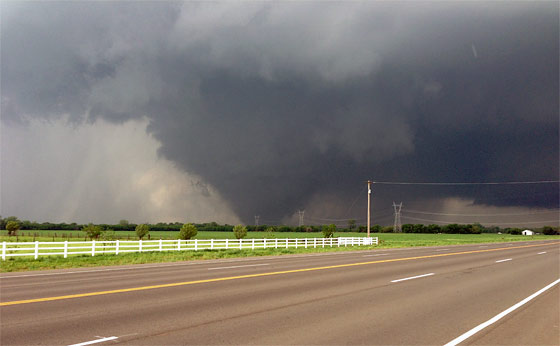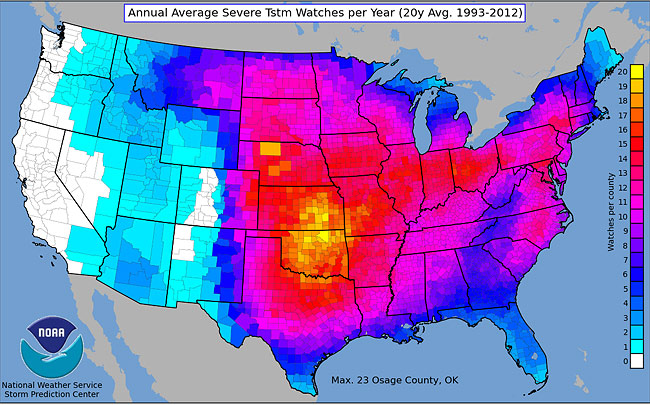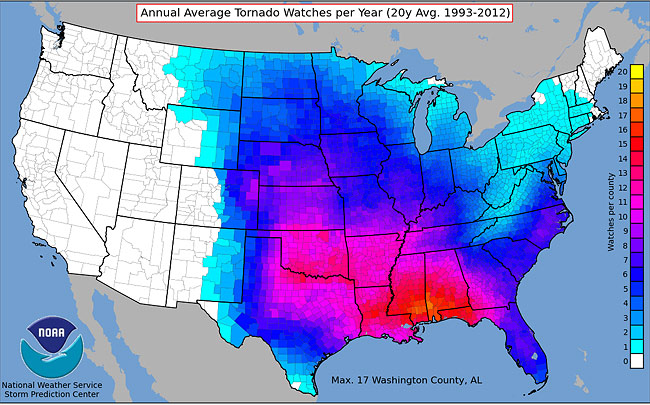Severe Weather Preparedness
Severe weather could happen at any time, anywhere.
In a weather emergency, being prepared to act quickly could be a matter of survival. This is especially true during the threat of severe weather.
The deadliest and most destructive tornado of 2013, an EF-5 on May 20 in Moore, Oklahoma with wind speeds of 210 mph killed 24 people, injured 377, and caused more than $2 billion in property damage. Even though severe weather was anticipated days in advance, many in the impacted areas did not have a plan and were caught unprepared.
Spring tends to produce more tornadoes. They’re also not uncommon in fall. During November 2013, a late season tornado outbreak that struck seven Midwestern states became the most active tornado day of 2013 with a total of 74 tornadoes.
Here’s what you can do to prepare for severe weather:
KNOW YOUR RISKS
Hurricanes, tornadoes, storms – every state in the United States experiences severe weather.
Map of severe thunderstorm watches per year
Map of tornado watches per year
TAKE ACTION
Make a plan, build a kit, and have the gear for emergency alerts…
Make A Plan
Your family may not be together when a disaster strikes so it is important to plan in advance: how you will get to a safe place; how you will contact one another; how you will get back together; and what you will do in different situations.
FamilyCommunication Tips
Identify a contact such as a friend or relative who lives out-of-state for household members to notify they are safe. It may be easier to make a long-distance phone call than to call across town, so an out-of-town contact may be in a better position to communicate among separated family members.
Be sure every member of your family knows the phone number and has a cell phone, coins or a prepaid phone card to call the emergency contact. If you have a cell phone, program that person(s) as “ICE” (In Case of Emergency) in your phone. If you are in an accident, emergency personnel will often check your ICE listings in order to get a hold of someone you know. Make sure to tell your family and friends that you’ve listed them as emergency contacts.
Text messages (also known as SMS or Short Message Service) can often get around network disruptions when a phone call might not be able to get through.
Build A Kit
A disaster supplies kit is simply a collection of basic items your household may need in the event of an emergency.
Try to assemble your kit well in advance of an emergency. You may have to evacuate at a moment’s notice and take essentials with you. You will probably not have time to search for the supplies you need or shop for them.
You may need to survive on your own after an emergency. This means having your own food, water and other supplies in sufficient quantity to last for at least 72 hours. Local officials and relief workers will be on the scene after a disaster but they cannot reach everyone immediately. You could get help in hours or it might take days.
Additionally, basic services such as electricity, gas, water, sewage treatment and telephones may be cut off for days or even a week, or longer. Your supplies kit should contain items to help you manage during these outages.
Emergency Alerts
Wireless Emergency Alerts (WEA) are emergency messages which can be pushed to newer cell phones for things like severe weather, etc. There are other various free apps which are readily available for smart phones.
Weather radios for the home or portable weather radios for on-the-go should be an essential ‘must-have’ prep for severe weather preparedness. Most all of them today have technology to automatically alert you of approaching severe weather based on your selection of transmitting stations.
BE AN EXAMPLE
Once you have taken action to prepare for severe weather, share your story with family and friends to inspire them to take action.
National Severe Weather Preparedness Week (MAR 2-8, 2014)
nws.noaa.gov
ready.gov



